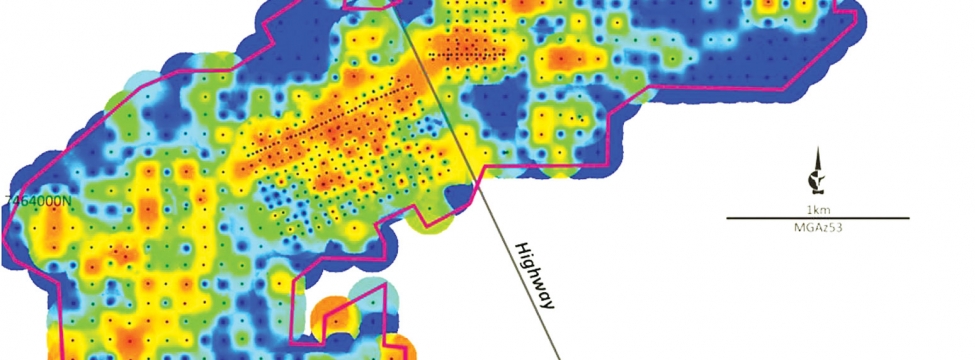To serve you better, our new website displays information specific to your location.
Please visit the site and bookmark it for future use.
The Napperby Project in Australia
The Napperby Uranium Project is located 175km northwest of Alice Springs in the Northern Territory of Australia. The mineralization occurs within a 20km paleochannel, trending approximately east-northeast. Carnotite mineralization resides mostly in sands and sandy clays as finely disseminated particles and blobs up to 5cm long; it can also be found in overlying calcrete as joint coatings.
This relatively low grade deposit was discovered and explored by CRA Exploration and Uranerz in the late 1970s. Toro Energy Limited has an option agreement with Deep Yellow Limited to acquire 100% of the project at a capped price per lb of contained resource.
Toro Energy commissioned SRK to estimate the resources of the deposit. Current drilling is a mixture of Deep Yellow and Toro Energy auger holes and Toro Energy sonic holes. The drill-hole spacing is mostly 100m x 100m with a central zone drilled at 50m x 50m and, very locally, some infilling at 25m x 25m.
The sonic holes proved quite successful in this mostly unconsolidated material, allowing excellent core recoveries. All samples were assayed for uranium and other chemical elements. Radiometric measurements down-hole were used to study the disequilibrium and establish the relationship between chemical grades and gamma-derived uranium grades (eU).
Because of the relatively large drill-hole spacing, it was difficult to establish a proper geological model; SRK used the Leapfrog™ software to create a mineralization envelope at a 50ppm threshold constraining the estimation.
Within this envelope, 1m composites were created, and analysed geostatistically. As expected, the variograms show poor continuity with ranges up to 110m, and high short-distance variability.
From a resource estimation viewpoint, the current drill spacing is large when compared to potential Selective Mining Unit (SMU) size.
Since direct estimation of the SMUs may lead to unacceptable biases and over-smoothing, it is preferable to use local recoverable estimation methods. These methods aim at estimating the proportion of ore within larger panels, the size of which is linked to the current data spacing. They account for the support effect (We are interested in SMU, not composite, grades) and can also handle the information effect (The final selection at mining stage will be based on grade control data, which implies some residual uncertainty in assessing the SMU grades).
Various methods exist for estimating local recoverable resources. The two most common are Multiple Indicator Kriging (MIK) and Uniform Conditioning (UC). In this case, SRK has selected the Uniform Conditioning method as giving a reasonable estimate of the local recoverable resources as an Inferred resource compliant under the JORC Code.
Daniel Guibal: dguibal@srk.com.au
This relatively low grade deposit was discovered and explored by CRA Exploration and Uranerz in the late 1970s. Toro Energy Limited has an option agreement with Deep Yellow Limited to acquire 100% of the project at a capped price per lb of contained resource.
Toro Energy commissioned SRK to estimate the resources of the deposit. Current drilling is a mixture of Deep Yellow and Toro Energy auger holes and Toro Energy sonic holes. The drill-hole spacing is mostly 100m x 100m with a central zone drilled at 50m x 50m and, very locally, some infilling at 25m x 25m.
The sonic holes proved quite successful in this mostly unconsolidated material, allowing excellent core recoveries. All samples were assayed for uranium and other chemical elements. Radiometric measurements down-hole were used to study the disequilibrium and establish the relationship between chemical grades and gamma-derived uranium grades (eU).
Because of the relatively large drill-hole spacing, it was difficult to establish a proper geological model; SRK used the Leapfrog™ software to create a mineralization envelope at a 50ppm threshold constraining the estimation.
Within this envelope, 1m composites were created, and analysed geostatistically. As expected, the variograms show poor continuity with ranges up to 110m, and high short-distance variability.
From a resource estimation viewpoint, the current drill spacing is large when compared to potential Selective Mining Unit (SMU) size.
Since direct estimation of the SMUs may lead to unacceptable biases and over-smoothing, it is preferable to use local recoverable estimation methods. These methods aim at estimating the proportion of ore within larger panels, the size of which is linked to the current data spacing. They account for the support effect (We are interested in SMU, not composite, grades) and can also handle the information effect (The final selection at mining stage will be based on grade control data, which implies some residual uncertainty in assessing the SMU grades).
Various methods exist for estimating local recoverable resources. The two most common are Multiple Indicator Kriging (MIK) and Uniform Conditioning (UC). In this case, SRK has selected the Uniform Conditioning method as giving a reasonable estimate of the local recoverable resources as an Inferred resource compliant under the JORC Code.
Daniel Guibal: dguibal@srk.com.au
|
You can download a PDF of the entire |
PDF A4
|
PDF Letter
|
|
|
|
Our newsletters focus on specific areas of interest to earth resource professionals and clients. Each is available as an Adobe Acrobat PDF file. If you don't already have Adobe's PDF reader, you can download it free.


